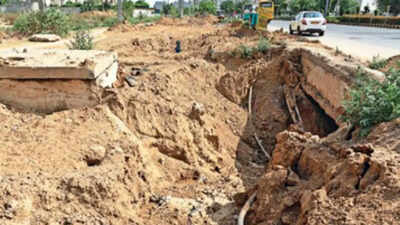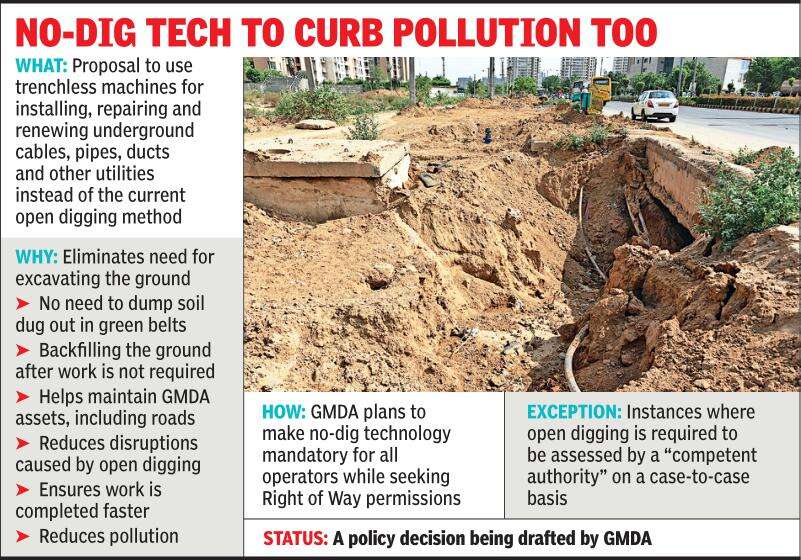- News
- City News
- gurgaon News
- How Gurugram Metropolitan Development Authority plans to stop roads from being dug up for infrastructural work
How Gurugram Metropolitan Development Authority plans to stop roads from being dug up for infrastructural work

Trenchless machines enable the installation, removal, or maintenance of utilities by minimising or removing the need for open excavation.
GURUGRAM: In a bid to restrict excavation and open digging and preserve green belts, the Gurugram Metropolitan Development Authority (GMDA) is planning to make the use of “trenchless machines” mandatory in the laying of underground utilities in areas within its jurisdiction.
Trenchless machines enable the installation, removal, or maintenance of utilities by minimising or removing the need for open excavation.

GMDA officials said the machines will prevent operators from dumping soil in green belts, help preserve roads, reduce disruptions normally caused by excavation, ensure faster work and also help in curtailing air pollution, an especially critical factor during the upcoming winter months.
“As of now, utilities are mostly being laid through open digging, which means excavating the portion. For example, in case of a road, one person digs up the road, then another comes and does some other work, then a third again digs it up for another reason. Such things weaken the road, which is continuously broken and relaid. The aim of using trenchless machines is to prevent this from happening. It will help maintain roads, green belts and other GMDA assets,” said a senior GMDA official.
“Once this policy is adopted, it will be mandatory for any operator carrying out work in the right of way (ROW) of GMDA to use trenchless machines instead of indulging in open digging. Around 95% of infrastructural work is possible through this method. If there are instances where work cannot be done through this means and open digging is required, the requirement will be assessed on a case-to-case basis by the authority. A policy decision is being worked upon,” the official said.
At the CPC meeting last month, the GMDA chief executive officer had also directed the chief engineers to ensure that a ground penetrating radar survey is done by every applicant applying for work within ROW of GMDA, and the applicant submits an as-built drawing after execution of the work. While the GPR survey shows the placement of utilities in terms of both location and depth prior to construction, as-built drawings depict the area where the work was undertaken after it is completed.
The GMDA chief had also directed that officials should ensure that a bank guarantee for the work is obtained and it is sufficient to ensure that the applicant uses trenchless machines to complete the work.
GMDA has been working on several plans to make the process of laying and maintaining utilities in the city smoother and faster, including procuring a GPR machine of its own and mapping all utilities laid down by different agencies and making the data available to the public on the OneMap portal.
Trenchless machines enable the installation, removal, or maintenance of utilities by minimising or removing the need for open excavation.

GMDA officials said the machines will prevent operators from dumping soil in green belts, help preserve roads, reduce disruptions normally caused by excavation, ensure faster work and also help in curtailing air pollution, an especially critical factor during the upcoming winter months.
According to officials, the matter had come up for discussion during a meeting of GMDA’s core planning cell (CPC) last month, following which the CPC had directed that trenchless machines be used for laying utilities. The chief engineers of infrastructure 1 and 2 divisions were also directed to draft a “policy decision” for the use of trenchless machines so that open digging may be restricted.
“As of now, utilities are mostly being laid through open digging, which means excavating the portion. For example, in case of a road, one person digs up the road, then another comes and does some other work, then a third again digs it up for another reason. Such things weaken the road, which is continuously broken and relaid. The aim of using trenchless machines is to prevent this from happening. It will help maintain roads, green belts and other GMDA assets,” said a senior GMDA official.
“Once this policy is adopted, it will be mandatory for any operator carrying out work in the right of way (ROW) of GMDA to use trenchless machines instead of indulging in open digging. Around 95% of infrastructural work is possible through this method. If there are instances where work cannot be done through this means and open digging is required, the requirement will be assessed on a case-to-case basis by the authority. A policy decision is being worked upon,” the official said.
At the CPC meeting last month, the GMDA chief executive officer had also directed the chief engineers to ensure that a ground penetrating radar survey is done by every applicant applying for work within ROW of GMDA, and the applicant submits an as-built drawing after execution of the work. While the GPR survey shows the placement of utilities in terms of both location and depth prior to construction, as-built drawings depict the area where the work was undertaken after it is completed.
The GMDA chief had also directed that officials should ensure that a bank guarantee for the work is obtained and it is sufficient to ensure that the applicant uses trenchless machines to complete the work.
GMDA has been working on several plans to make the process of laying and maintaining utilities in the city smoother and faster, including procuring a GPR machine of its own and mapping all utilities laid down by different agencies and making the data available to the public on the OneMap portal.
FacebookTwitterLinkedinEMail
Start a Conversation
end of article
Quick Links
Delhi Air PollutionDelhi TemperatureChennai WeatherBangalore TemperatureCovid vaccination centres in DelhiCoronavirus in DelhiRTPCR test in GurgaonHyderabad RainPollution level in BangaloreDelhi SmogDelhi TemperatureNoida AQIGurgaon AQI todayFire in MumbaiMumbai RainsCovid 19 RT PCR Test in NoidaDelhi AQI todaySrinagar encounter

